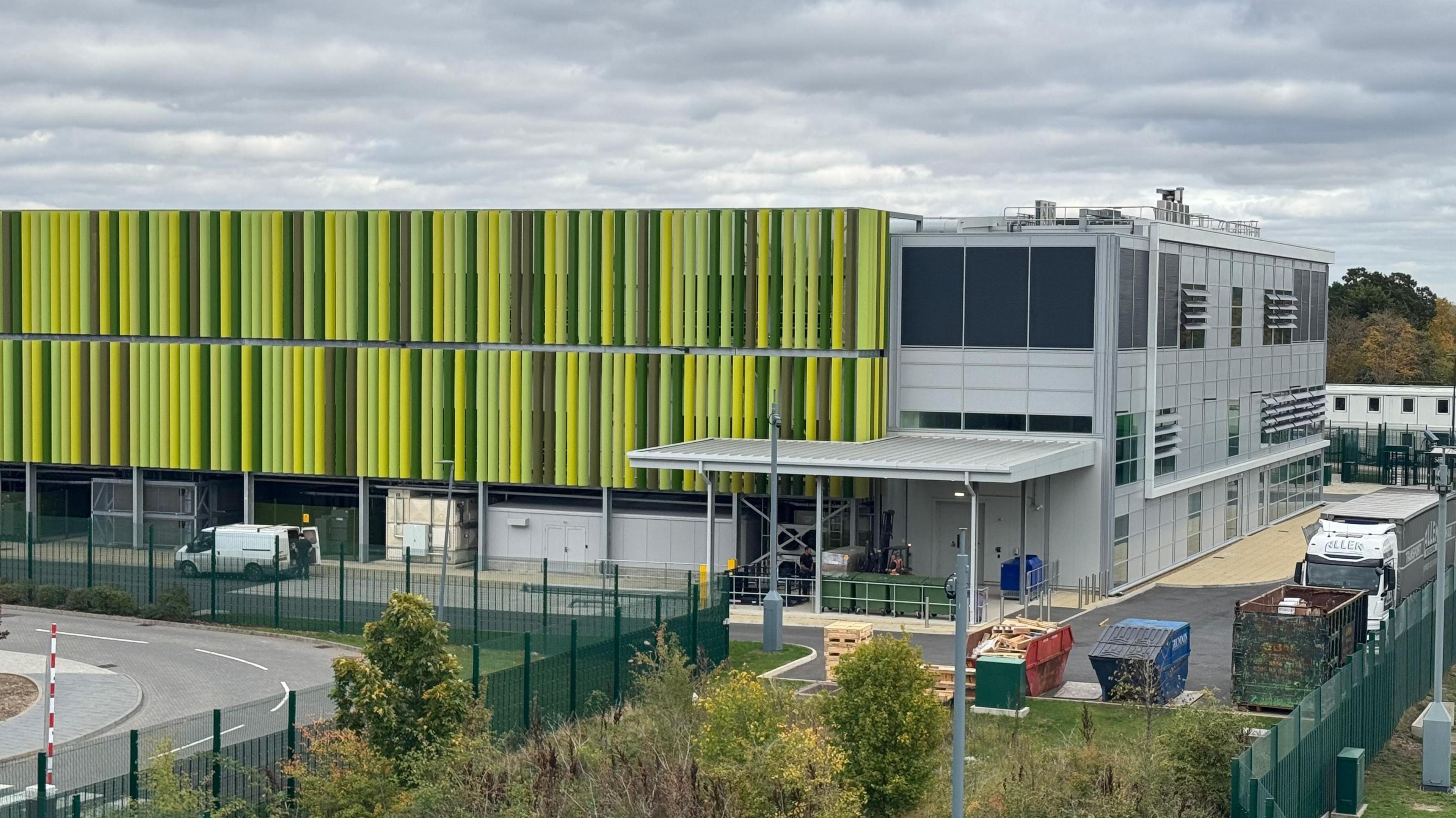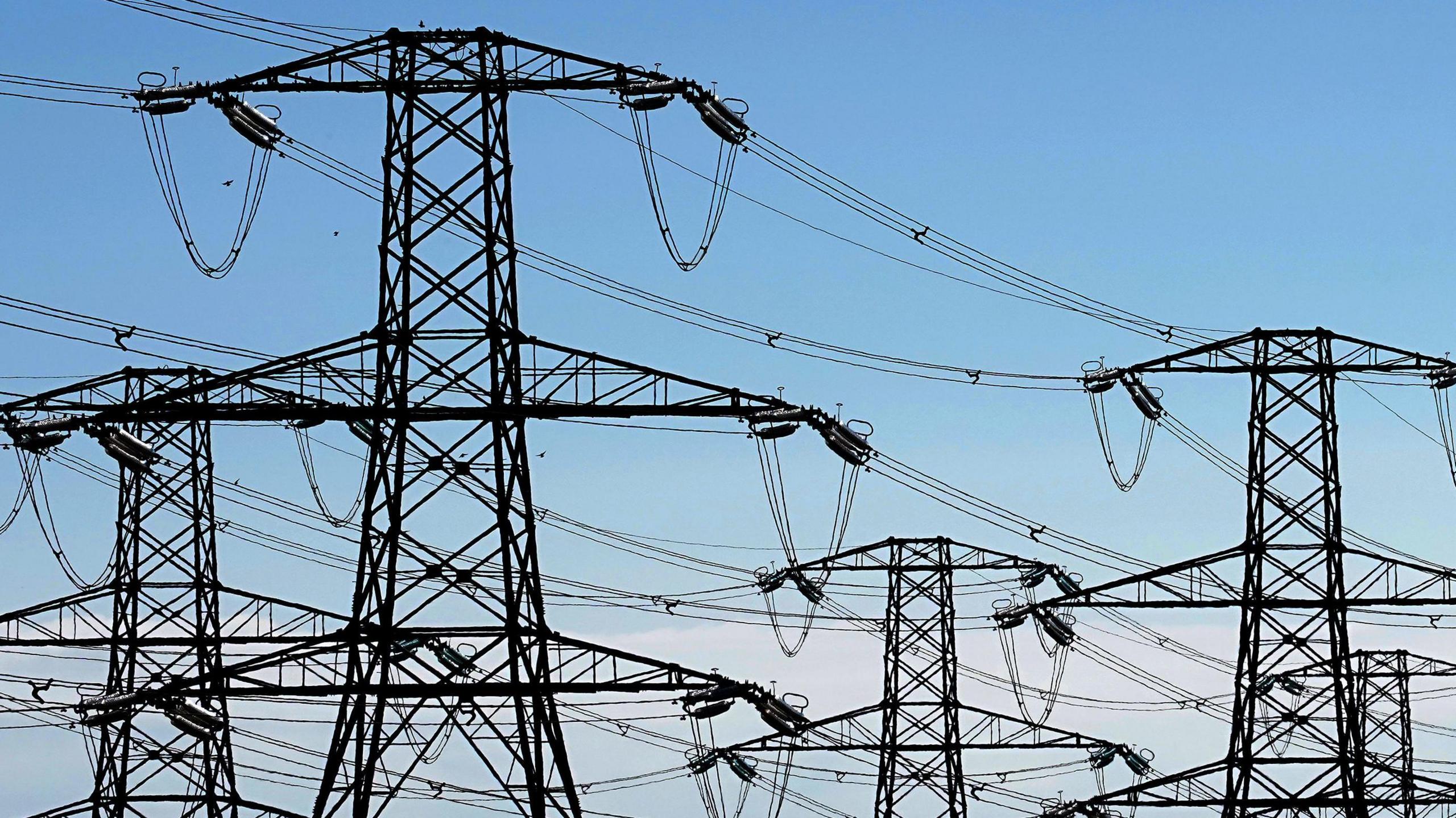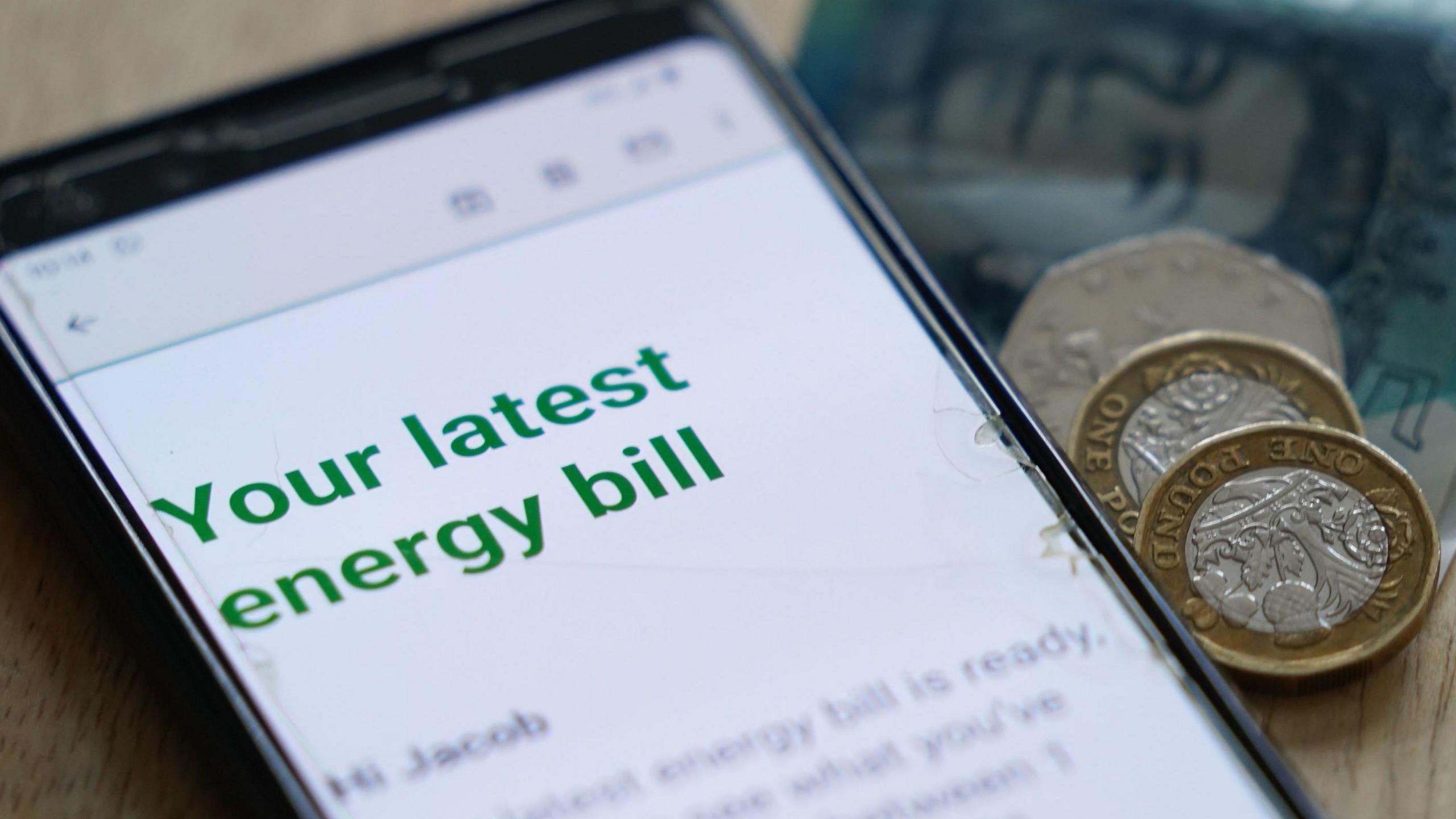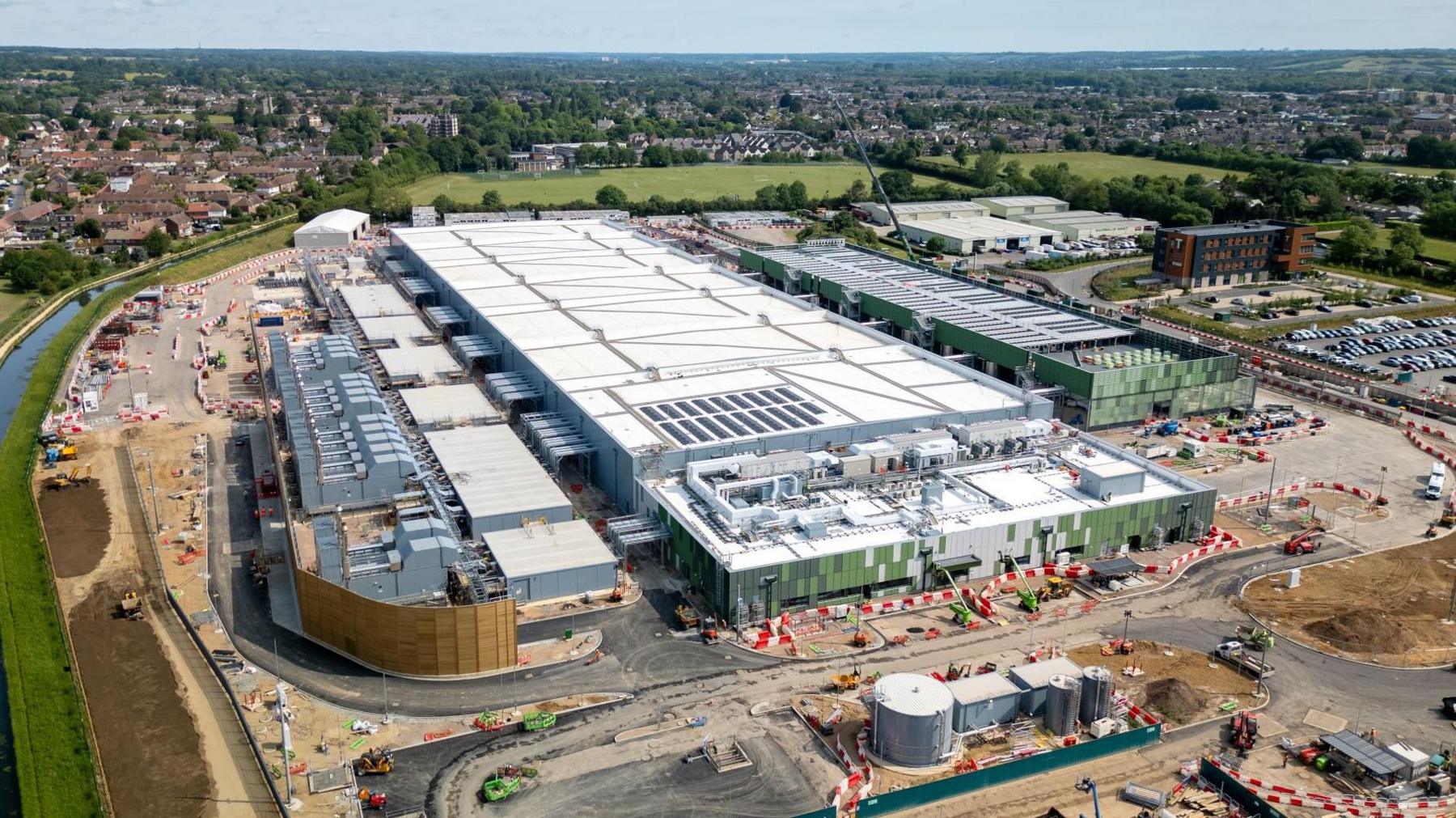What are data centres and are more coming to the East?

Kao Data park in Harlow is constructing a third data centre, which is due to open in 2026
- Published
For decades data centres - large warehouses full of powerful computers used to run digital services - have been quietly supporting our everyday lives, but why are they important and could more be built in the East of England?
There are currently estimated to be about 500 data centres across the UK and the government says they are as critical for the country as emergency services and the NHS.
Google built a $1bn (£735m) data centre in Waltham Cross, Hertfordshire, in September and a £1.3bn facility has been approved for development in Basildon, Essex.
What are data centres?
Data centres are the physical facilities that store, process and run large amounts of data and software which power the internet.
Some organisations operate their own centres, such as the University of Cambridge, to enable its research, and Lloyds Bank, which uses its centre in Peterborough to support ATMs and online banking.
Colocation data centres, such as Kao Data's facility in Harlow, Essex, are sites where businesses can rent space to house their own IT equipment and servers.
Hyperscale data centres are the largest type of site and are usually operated by big companies such are Google and Microsoft to facilitate public internet and cloud use - when something is saved on the internet, instead of stored on a phone, tablet or computer.
What do we use data centres for?
Many of us interact with a data centre hundreds of times of day, such as when we make a bank transaction, stream a film or video game, shop online, send emails and texts, or use an app to control our central heating.
Every time someone saves a photo or document to the cloud, it would be stored in a data centre.
For example, the European Bioinformatics Institute, external in Cambridge collects data from worldwide scientific research and stores it at the Kao Data park in Harlow.
Johanna McEntyre, the company's interim director, said: "If our data was written down and the books stacked on top of each other, they'd reach the moon and back several times.
"We have 120 million requests for our data every day, saving scientists time and money by not repeating experiments which have already been done.
"In the pandemic we hosted all of the molecular biology about the virus which was essential for those developing a vaccine."
Could more centres be built in the East?

Most data centres are powered by the National Grid
Data centres have been around for decades and London has more than any other European city.
As the growth in artificial intelligence (AI) increases so does the need for processing power.
The construction researchers Barbour ABI research suggests the number of data centres in the UK is set to increase by almost a fifth.
The government has not included the East of England as an AI Growth Zone, external, but with close proximity to London's digital-heavy sectors it could become a viable location for more data centres.
People in the UK use data centres based in other countries, but two advantages of having them in the country include quicker access to the data, which is important in streaming to enable smooth playback.
The second is the data the centres hold can be governed and protected by UK laws - known as digital sovereignty - although this is not always the case with UK centres owned and operated by foreign companies.
How much energy do data centres use?
How much energy data centres use is difficult to establish. The energy consumption is also partly down to consumers, as choosing an AI chatbot, such as ChatGPT, to answer a question uses more energy than a regular internet search.
Gina Neff, the executive director of the Minderoo Centre for Technology and Democracy at Cambridge University, said: "At the moment, data centres aren't compelled to report how much energy or water they're using."
The government said data centres currently consume about 2.5% of the UK's electricity, external, although it expects that figure to increase four-fold by 2030.
A data centre's capacity is calculated as how much energy it could draw upon at any given moment. This determines the amount of computing it can support, but a significant amount of energy is also used in cooling the equipment.
At Kao Data park there are two 10 megawatts centres and a 17 megawatts centre under construction.
For comparison, Ofgem estimates that one megawatt of energy would power 2,000 UK homes for an hour, external.
Hyperscale data centres typically require more than 100 megawatts of power.
A report by Massachusetts Institute of Technology, external estimated that creating a five-second video with new AI models uses the same amount of energy as running a microwave for more than an hour.
Where does the energy come from?

Some believe the cost of building more infrastructure to carry energy to the areas it is needed may be passed onto consumers
Although many data centres are exploring renewable energy options, most data centres rely on power for the National Grid.
Kao Data park in Harlow has signed an agreement with Downing Renewable Developments to build a solar farm nearby, which would "private wire" up to 40 megawatts of power directly to the park and bypass the National Grid.
The plan will now go to the Epping Forest District Council for consideration, but is said to be one of the first projects of its scale in the UK.
There are also calls for data centres to be built in areas that have under-used renewable energy plants.
Spencer Lamb, the managing director at Kao Data, said: "In Scotland, the government essentially pays wind farm companies to switch off their turbines because the grid can't cope with the amount of energy they're producing.
"If we could private wire data centres to those turbines or similar sources, it would cut costs for taxpayers and make use of energy that is currently wasted."
The computers in data centres work constantly which creates a lot of heat, which has led to some data centres being air-cooled. However, liquid is a better heat conductor and therefore widely used.
In the US, many data centres use evaporative cooling - where hot air from the server rooms is drawn through water soaked pads and cooled as the water evaporates.
In other parts of the UK, closed-loop systems are more common and use less water.
The East of England is one of the driest regions in the UK and so concerns have been raised about water consumption of data centres.
Anglian Water has suggested that using "treated sewage effluent" could be a solution.
Will our energy bills increase?
There is demand for new connections to the National Grid, external across the UK from a wide range of companies, including data centres and new housing estates.
Some believe the cost of building more infrastructure to carry energy to the areas it is needed may be passed onto consumers.
Others argue that if data centre companies contribute to the costs of infrastructure, or private wire connections, consumers could benefit.
Get in touch
Do you have a story suggestion for the East of England?
Follow East of England news on X, external, Instagram, external and Facebook: BBC Beds, Herts & Bucks, external, BBC Cambridgeshire, external, BBC Essex, external, BBC Norfolk, external, BBC Northamptonshire, external or BBC Suffolk, external.
Related topics
- Published15 August

- Published16 September
